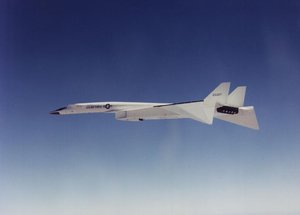XB-70 Valkyrie
|
|
The North American XB-70 "Valkyrie" was conceived for the Strategic Air Command in the 1950s as a high-altitude bomber that could fly three times the speed of sound (Mach 3). The Valkyrie was configured as a canard delta wing, built largely of stainless steel honeycomb sandwich panels and titanium. It was designed to make use of a phenomenon called "compression lift," achieved when the shock wave generated by the airplane flying at supersonic speeds supports part of the airplane's weight. For improved stability at supersonic speeds, the Valkyrie could droop its wingtips as much as 65 degrees.
Drooping the wingtips also strengthened the compression lift effect — with the wingtips drooped downwards, the shock wave caused by the compression wedge at the center of the wing would be further trapped under the wings, rather than simply flowing out past the end of the wings. Partially as a result of this, the XB-70 holds the record for the highest lift-to-drag ratio on a manned aircraft, only later bested by the highly specialized D-21 drone.
Following the downing of the U-2 flown by Gary Powers, the viability of the XB-70 as a bomber was questioned, and the program was changed to a research program for the advanced study of aerodynamics, propulsion, and other subjects related to large supersonic aircraft. Initial plans were made to build 3 aircraft, each one incorporating modifications based on lessons learned from the previous aircraft's flight tests, but the program was cut down to two aircraft in July 1964.
The first XB-70 made its maiden flight on September 21, 1964. The first aircraft would be found to suffer from weaknesses in the honeycomb construction, and was continually troubled by hydraulic leaks, fuel leaks, and problems with the aircraft's unusually complicated landing gear. In flight on May 7th, 1965, the divider separating the left and right halves of the engine inlet broke off and was ingested into the engines, damaging all six beyond repair. On October 14, 1965, on the first flight exceeding a speed of Mach 3, the stress again damaged the honeycomb construction, leaving two feet (600 mm) of the leading edge of the left wing missing. These construction problems resulted in the imposition of a speed limit of Mach 2.5 on the first aircraft.
These problems were almost completely solved on the second aircraft, which first flew on July 17, 1965. On May 19th, 1966 aircraft number two flew 2,400 miles (3,840 km) in 91 minutes, attaining Mach 3 for 33 minutes of that flight. On June 8, 1966, however, it crashed following a mid-air collision (http://www.check-six.com/Crash_Sites/XB-70_crash_site.htm) with an F-104 that occurred while the aircraft were flying in close formation for a photo shoot. NASA Chief Test Pilot Joe Walker, piloting the F-104, and Carl Cross, copilot aboard the XB-70, were both killed in the crash, while Al White, the XB-70's pilot, successfully ejected.
The first aircraft with its limited abilities continued research, making 33 more research flights. On February 4, 1969, Valkyrie number one was retired and flown to the National Museum of the United States Air Force at Wright Patterson Air Force Base near Dayton, Ohio.
The XB-70 caused so much concern in the Soviet Union that a special fighter aircraft design program was created to counter it. Though the XB-70 was cancelled, this program resulted in the high-speed MiG-25 interceptor.
The Russian Sukhoi T-4 was a medium-range bomber prototype that borrowed many design features of the XB-70.
Specifications (XB-70A)
General characteristics
- Crew: 2
- Length: 185 ft 10 in (56.6 m)
- Wingspan: 105 ft 0 in (32 m)
- Height: 30 ft 9 in (9.4 m)
- Wing area: 6,296 ft² (585 m²)
- Empty: 210,000 lb (93,000 kg)
- Loaded: 534,700 lb (242,500 kg)
- Maximum takeoff: 550,000 lb (250,000 kg)
- Powerplant: 6× General Electric YJ93-GE-3; 28,000 lbf (133 kN) thrust
Performance
- Maximum speed: Mach 3.1
- Maximum speed: 2,050 knots (3,800 km/h)
- Combat range: 4,288 miles (7,900 km)
- Ferry range: miles ( km)
- Service ceiling: 77,350 ft (23,600 m)
- Rate of climb: ft/min ( m/min)
- Wing loading: 84.93 lb/ft² (414.7 kg/m²)
- Thrust/weight ratio: 0.314 lbf/lb (3.1 N/kg)
XB-70_takeoff.jpg
Aircraft
- A Full scale mock-up was completed in February 1959.
- XB-70A #1 - (NA-278) 62-0001, 83 flights; total time: 160 hours - 16 minutes - At the U.S. Air Force Museum near Dayton, OH (http://www.wpafb.af.mil/museum/research/bombers/b5/b5-63.htm)
- XB-70A #2 - (NA-278) 62-0207, 46 flights; total time: 92 hours - 22 minutes - Crashed on 8 June 1966 north of Barstow, CA (http://www.Check-Six.com/Crash_Sites/XB-70_crash_site.htm)
- XB-70B #3 - (NA-274) 62-0208 originally to be first YB-70A in March 1961, this advanced prototype was cancelled in March 1964 while under construction.
- YB-70A - additional 10 advanced prototypes cancelled in December 1960. These YB-70's would have been modified to B-70A specifications at completion of testing.
- B-70A - planned fleet of 50 operational bombers (with wing-tip fuel tanks) cancelled in December 1959.
- RS-70 - alternate planned fleet of 50 reconnaissance aircraft (with in-flight refuelling capability) was evaluated in February 1959.
External links
- Unreal Aircraft - North American XB-70 Valkyrie (http://unrealaircraft.com/classics/xb70.php)
- NASA XB-70 videos (http://www.dfrc.nasa.gov/Gallery/Movie/XB-70/HTML/EM-0039-05.html)
- NASA B-70 aircraft study (PDF format) Vol.1 (http://ntrs.nasa.gov/archive/nasa/casi.ntrs.nasa.gov/19950002358_1995102358.pdf) Vol.2 (http://ntrs.nasa.gov/archive/nasa/casi.ntrs.nasa.gov/19950002359_1995102359.pdf) Vol.3 (http://ntrs.nasa.gov/archive/nasa/casi.ntrs.nasa.gov/19950002360_1995102360.pdf) Vol.4 (http://ntrs.nasa.gov/archive/nasa/casi.ntrs.nasa.gov/19950002361_1995102361.pdf)
- The B-70 Valkyrie at FAS (http://www.fas.org/nuke/guide/usa/bomber/b-70.htm)
Original contents of this page copied from USAF Museum web site (http://www.wpafb.af.mil/museum/modern_flight/mf37.htm).
Related content
Related development: XF-108 Rapier
Comparable aircraft: Sukhoi T-4
Designation sequence: GAM-67 - XB-68/SM-68 - RB-69 - XB-70 - SR-71 - XGAM-72 - XSM-73
Related lists: List of military aircraft of the United States - List of bomber aircraft
|
Lists of Aircraft | Aircraft manufacturers | Aircraft engines | Aircraft engine manufacturers Airports | Airlines | Air forces | Aircraft weapons | Missiles | Timeline of aviation |

